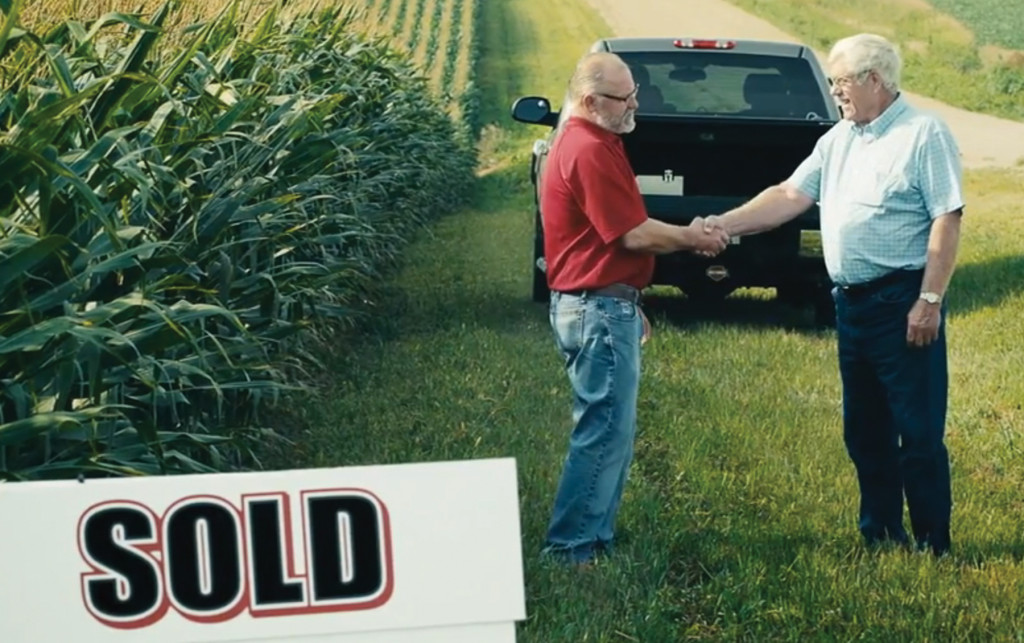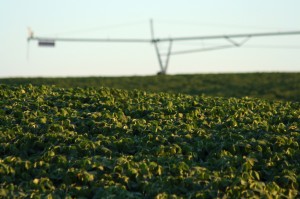
As farmers begin to wrap up harvest 2016 amidst low grain prices, it’s no surprise that cash rental rates across the state and region have followed suit. The USDA released its annual update on farmland market conditions in August, and highlighted the drop in US land values and rental rates nearly across the board.
Nationally, the average cropland cash rent fell 6 percent—$136 per acre lower—in 2016, after the long upward climb that began in 2008. Since 1998, the only other time the cash rental rate has seen a decline was in 2007, with a 3 percent drop.
Despite the overall decline, overall changes at the state level were much more variable. In the Midwest, Minnesota and Iowa showed the greatest decline in cash rents, similar to most other Midwest and Great Plains states. The only two states to show in increase were Michigan and Wisconsin.
Nebraska’s farmland real estate value—the value of all land and buildings on farms—decreased 3.3 percent from 2015, averaging $2,950 per acre. Similarly, Nebraska’s cropland value fell 4.3 percent from 2015, with an average value of $4,850 per acre.
Nationally, average rental rates for pasture land also saw declines in 2016—7 percent in total from 2015 highs, although Nebraska pastureland increased $40 per acre from 2015, at $910 per acre.
More specifically, for Nebraska, the dryland cropland value averaged $3,800 per acre, down $170 from 2015, while irrigated cropland averaged $6,560 per acre, also down from 2015’s $310 per acre average.
Looking expressly at cash rental rates in the Cornhusker state, renters paid less to landlords in 2016 than in 2015. Irrigated cropland cash rent average $243 an acre, an $11 decrease from 2015. For dryland cropland, rents averaged $150 per acre, down $10 from the previous year. Pastureland cash rental rates average $24 per acre, down $4.50 from 2015.
While cash rental rates are falling, a survey recently conducted by ProFarmer found that more farmers may choose to walk away from ground that can’t be renegotiated—another possible contributing factor to the trend, aside from other more obvious factors, chiefly lower commodity prices.
ProFarmer LandOwner newsletter editor Mike Walsten said, “According to our survey, we found that 44 percent of members and subscribers are willing to walk away from a cash lease if that lease is not lowered going into 2017.”
Based on these numbers—and similar sentiments shared elsewhere—cash rent conversations could be tough. Facing the decision to buy, sell, or walk away from pricey cash rents will be difficult the next year, but trying to keep emotions out of that decision is encouraged by farm managers.
Are you facing concerns about your rented ground, or nervous about looming cash rental negotiations? Please let an experienced UFARM land manager take the pressure off. We have the practical knowledge and necessary skills to help both parties reach a mutually agreeable rental price during this adjustment period.
UFARM offers a full range of Nebraska land management services, including real estate sales, rural property appraisals, consultations and crop insurance. UFARM has operated in Nebraska since the early 1930’s. If you have questions about yields and productivity on your rented farmland, give the UFARM managers contact us today!
Sources consulted: “NE Farm Real Estate Values Down 3 Percent from 2015; Cash Rents Also Down.” UNL Cropwatch. University of Nebraska-Lincoln. 05 Aug. 2016. Web. 26 Oct. 2016.Morgan, Tyne. “More Farmers Walking Away from Pricey Cash Rents.” AgWeb.com. Farm Journal. 25 Oct. 2016. Web. 26 Oct. 2016.Widmar, David. “Most States See Cash Rental Rates Fall, Economist Says.” Agriculture.com/Successful Farming. Meredith AgriMedia. 24 Oct. 2016. Web. 26 Oct. 2016.

 At some point or another, many landowners will face the decision on whether it’s in their best interest to sell or lease some or all of their Nebraska farmland. The decision to sell farmland is often guided by emotional and/or financial concerns, and understandably so. Many landowners may attempt, in the end, to lease their land instead. A number of issues play a factor in this decision, but considering all available options is necessary before reaching a decision on whether to sell or lease your land.
At some point or another, many landowners will face the decision on whether it’s in their best interest to sell or lease some or all of their Nebraska farmland. The decision to sell farmland is often guided by emotional and/or financial concerns, and understandably so. Many landowners may attempt, in the end, to lease their land instead. A number of issues play a factor in this decision, but considering all available options is necessary before reaching a decision on whether to sell or lease your land. Aside from the day-to-day duties of owning and managing land, one of the more difficult aspects of land ownership deals with leasing farm land. Many landowners have difficulties coming to mutually acceptable agreements, getting those agreements on paper, determining fair rental rates, and determining what type of lease agreement best suits their needs. What are the leasing basics of which landowners should have a firm grasp?
Aside from the day-to-day duties of owning and managing land, one of the more difficult aspects of land ownership deals with leasing farm land. Many landowners have difficulties coming to mutually acceptable agreements, getting those agreements on paper, determining fair rental rates, and determining what type of lease agreement best suits their needs. What are the leasing basics of which landowners should have a firm grasp? As we head into the final stretch of August, farmers are already looking ahead to harvest. While they focus on putting pivots to rest in the near future and begin pulling out the harvest equipment, it’s a good idea for farmers and landowners in rental agreements to remember that September 1st marks the date by which lease agreements must be terminated or terms and conditions changed, if it is so desired by either party.
As we head into the final stretch of August, farmers are already looking ahead to harvest. While they focus on putting pivots to rest in the near future and begin pulling out the harvest equipment, it’s a good idea for farmers and landowners in rental agreements to remember that September 1st marks the date by which lease agreements must be terminated or terms and conditions changed, if it is so desired by either party. Landowners are always endeavoring to get the most from their farmland, and this is especially true when negotiating cash rental rates with potential tenants. While there are many factors in play when it comes to lease rates, one of the most significant is whether or not their parcel of land is under center pivot irrigation. As many savvy landowners readily discover, there is a strong correlation between higher cash rental rates and the presence of center pivot irrigated acres.
Landowners are always endeavoring to get the most from their farmland, and this is especially true when negotiating cash rental rates with potential tenants. While there are many factors in play when it comes to lease rates, one of the most significant is whether or not their parcel of land is under center pivot irrigation. As many savvy landowners readily discover, there is a strong correlation between higher cash rental rates and the presence of center pivot irrigated acres.